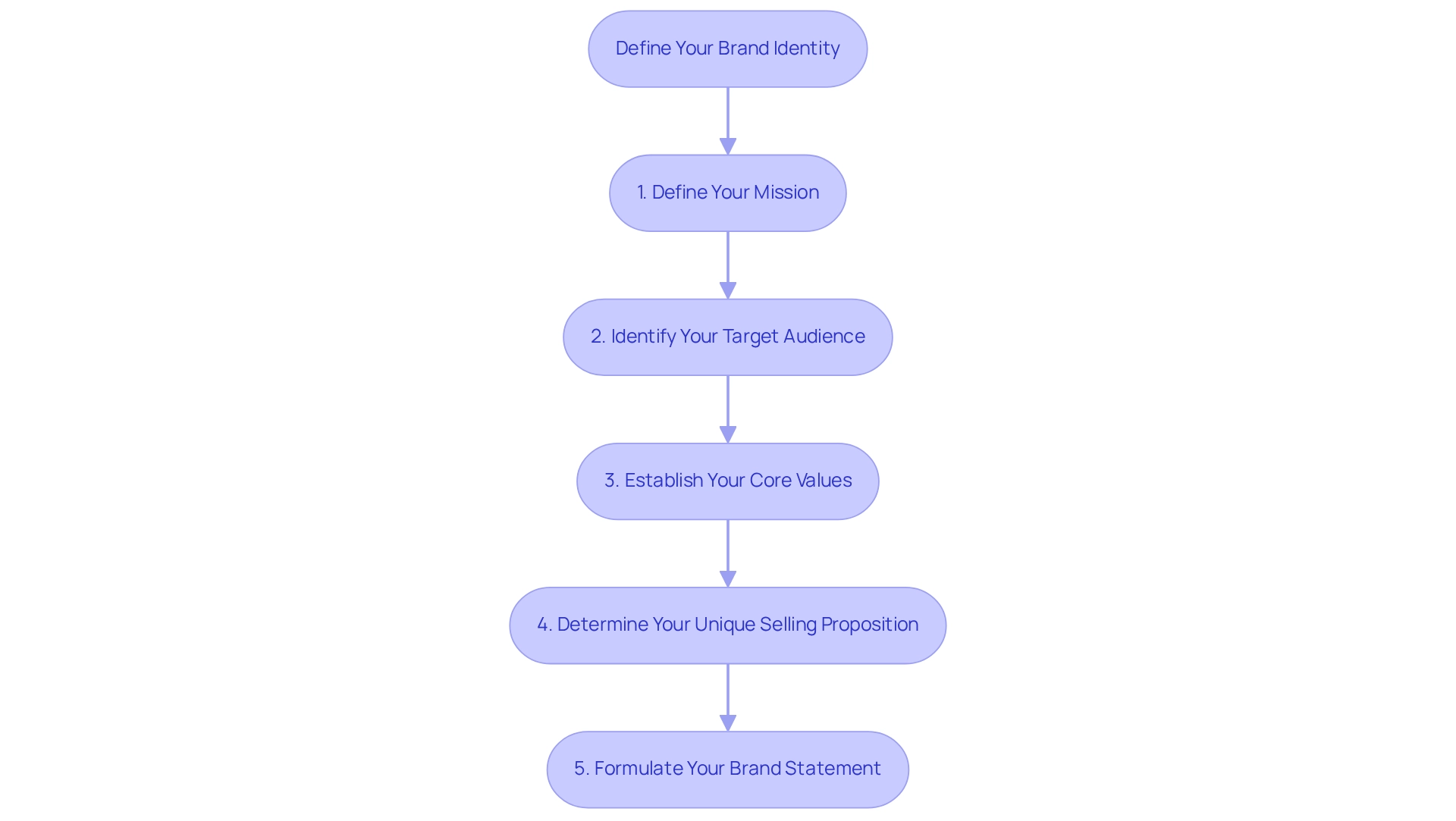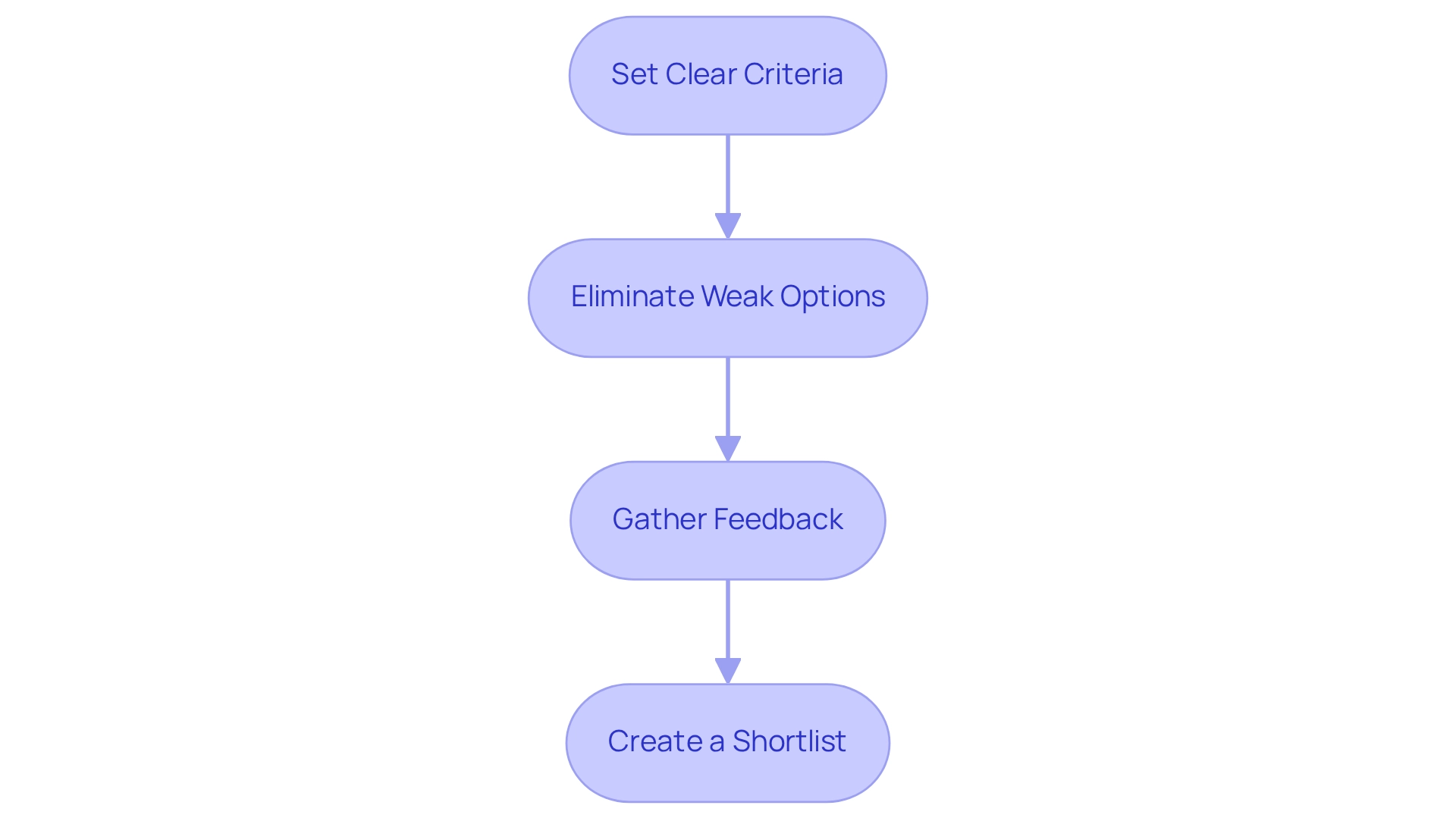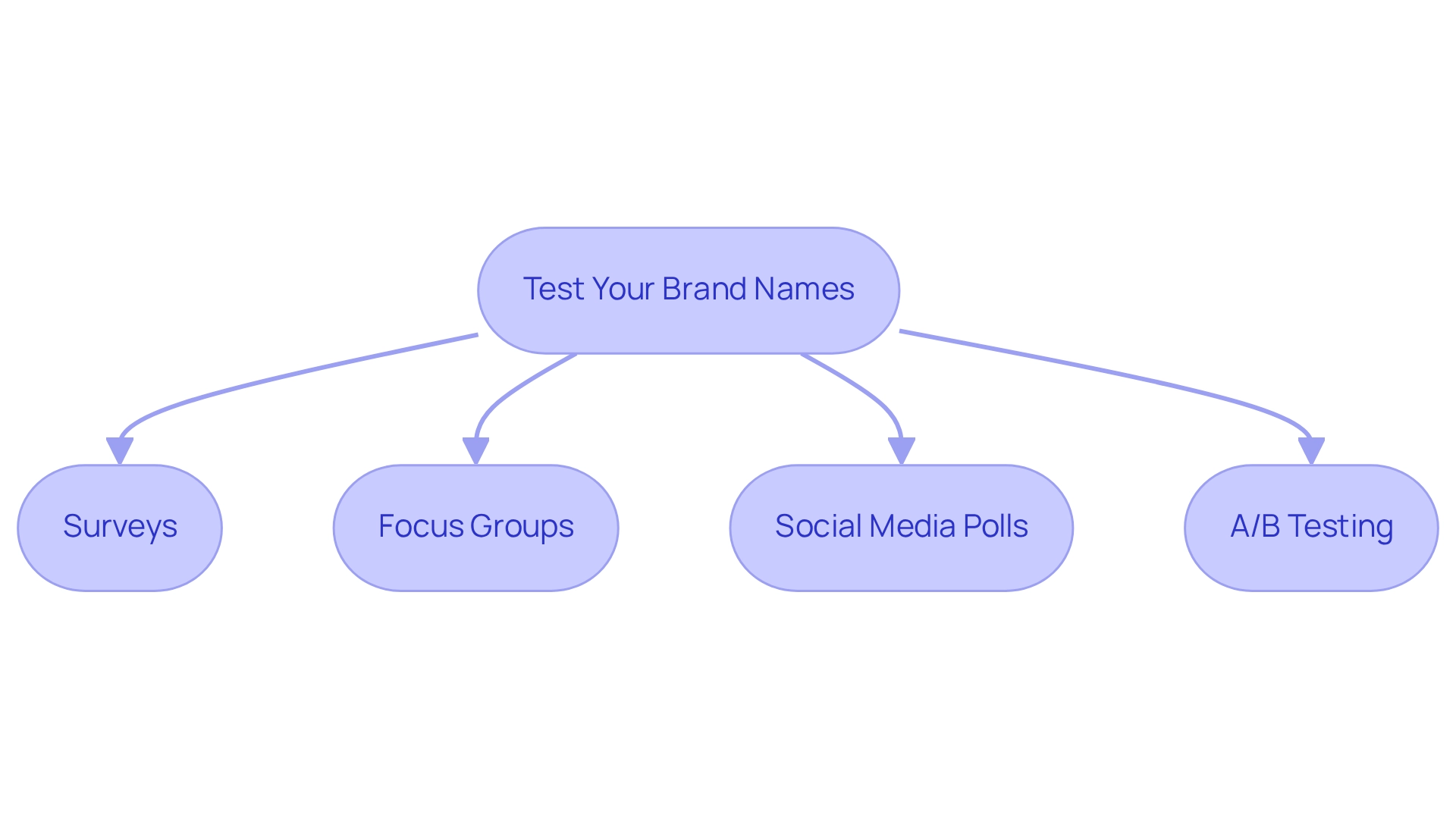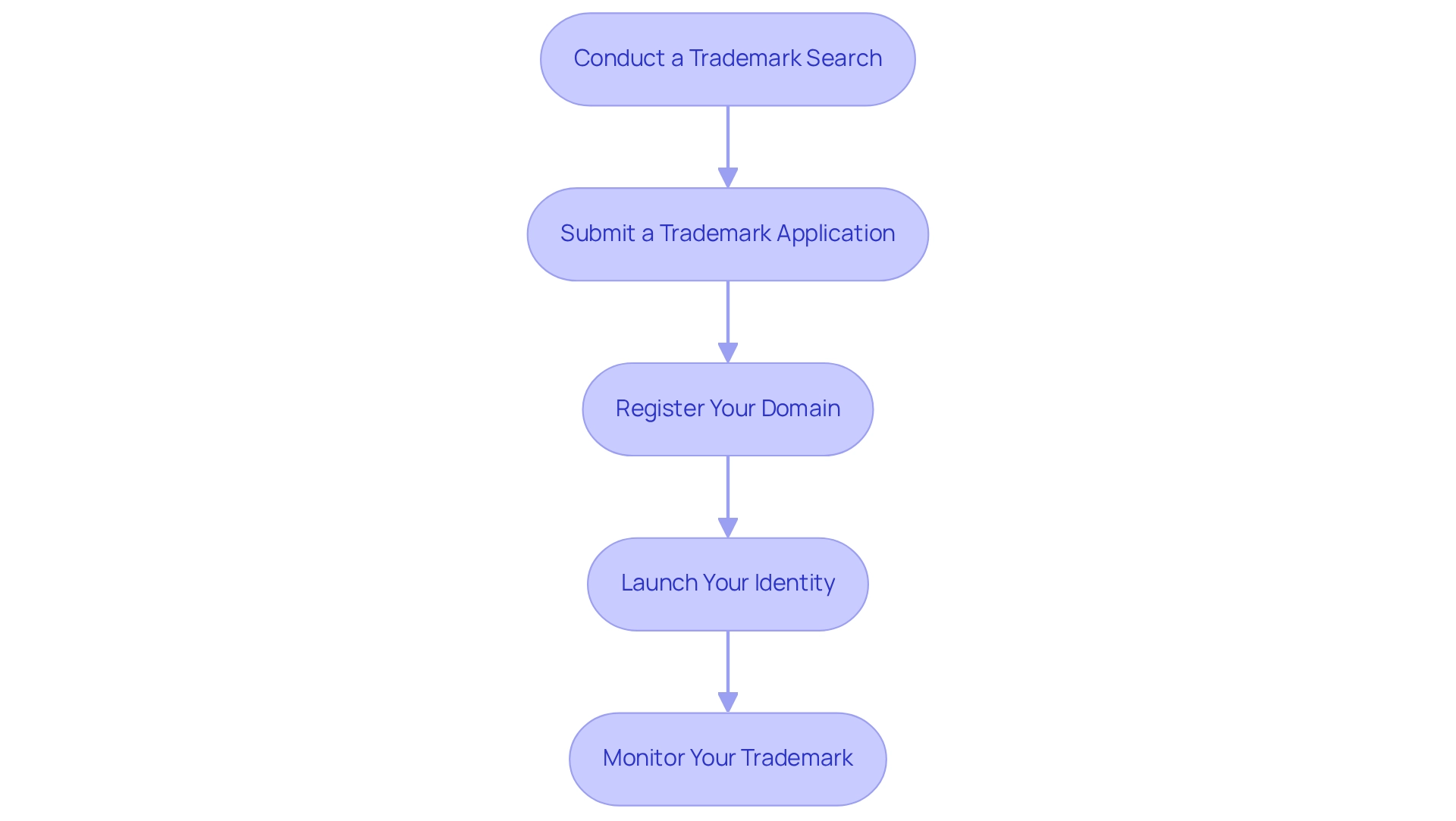Overview
The article presents a heartfelt approach to effective brand naming for tech startups, recognizing the struggle many founders face in defining their brand identity. It emphasizes the importance of:
- Generating name ideas
- Refining options
- Testing with target audiences
- Securing trademarks
Each step is illustrated with strategic methods and examples, highlighting how clarity in mission, understanding the audience, and engaging with the community can lead to a brand name that truly resonates with both the founders' vision and the target market.
This journey is not just about a name; it’s about crafting an identity that reflects passion and purpose. By nurturing these elements, tech startups can find a name that speaks to their mission and connects with their audience on a deeper level.
Introduction
In the competitive landscape of startups, many founders face the daunting challenge of establishing a strong brand identity. This journey, while rewarding, often feels overwhelming as businesses strive to stand out in a crowded market. The implications of not having a recognizable name can weigh heavily, leaving entrepreneurs feeling lost and uncertain. However, there is hope. This article gently guides you through the essential steps for defining your brand identity, generating creative name ideas, and refining those options into a shortlist that resonates with your target audience. By thoughtfully testing potential names and securing trademarks, you can confidently launch your brand into the marketplace. With practical insights and strategic guidance, this exploration serves as a nurturing roadmap for entrepreneurs eager to carve out their unique space in the business world.
Define Your Brand Identity
To define your brand identity, it’s essential to start by reflecting on some important questions:
- What is your mission? Take a moment to clearly articulate what your startup aims to achieve. This clarity will guide your naming process. For instance, consider how the collaboration of the organization with the EOS Network Foundation exemplifies the power of a clear mission in driving innovation in digital branding.
- Who is your target audience? Understanding the demographics, preferences, and pain points of your is crucial. The company’s efforts with clients such as Interos and Amount highlight just how significant it is to know your audience in order to customize your identity effectively.
- What are your core values? Identifying the principles that guide your business decisions and interactions is vital. The collaborations showcase how aligning your values with those of your partners can promote growth and foster meaningful connections.
- What makes you unique? Determine your unique selling proposition (USP) that sets you apart from competitors. The achievements of the company in revolutionizing products like LOLIWARE and Flowhaven illustrate how a powerful USP can lead to substantial market influence.
Once you have these elements outlined, take the time to formulate a statement that captures your essence. This statement will serve as a reference point throughout the naming process, much like how RNO1's strategic partnerships have guided their clients in establishing impactful brand identities. Remember, you are not alone in this journey; there is a community ready to support you as you navigate the exciting world of branding.

Generate a Longlist of Name Ideas
The process of brand naming for your startup can feel overwhelming, and it’s easy to get stuck. Many founders experience anxiety about brand naming, as they want to choose the perfect name that reflects their vision and values. But fear not, you’re not alone in this journey. Here are some nurturing steps to help you generate a longlist of name ideas with ease:
- Brainstorming Session: Gather your team for a brainstorming session. Encourage everyone to contribute ideas without judgment, creating a safe space for creativity.
- Use Naming Tools: Utilize online title generators or tools like Namekon to . These resources can help you think outside the box and discover new possibilities.
- Word Association: Write down words connected to your identity, mission, and values. Combining these words in creative ways can lead to unexpected and meaningful names.
- Cultural References: Consider titles that draw from mythology, literature, or other cultural references that align with your brand. These connections can add depth and resonance to your brand naming.
- Keep It Simple: Aim for titles that are easy to spell, pronounce, and remember. Simplicity often leads to stronger recognition and recall.
As you gather all these concepts into a document, strive for a minimum of 50 possible titles. Remember, each idea is a step closer to finding a name that truly resonates with your vision. Embrace the process, and trust that the right name will emerge.

Refine and Shortlist Your Brand Names
Choosing the right brand naming can feel overwhelming, especially for startup founders who want to make a lasting impression. It’s essential to find a name that truly reflects your business identity and resonates with your audience. To help ease this process, consider these steps to refine and with care and intention.
- Set clear criteria. Think about what matters most to you: relevance to your business persona, distinctiveness, and ease of pronunciation. These standards will serve as your guiding light in the brand naming process.
- Eliminate weak options. Review your longlist and gently remove any entries that don’t meet your criteria or align with your brand identity. This step can be tough, but remember, it’s about brand naming to find that perfect fit.
- Gather feedback. Share your remaining options with trusted colleagues or mentors. Their insights can provide valuable perspectives on the appeal and relevance of your titles, assisting you in brand naming and helping you feel more confident in your choices.
- Create a shortlist. Aim to narrow it down to 5-10 names that resonate deeply with you. These will be the titles you evaluate with your target audience, paving the way for a name that truly embodies your vision.
By following these steps, you’re not just involved in brand naming; you’re embarking on a journey of discovery that reflects your passion and purpose. Embrace this process, and know that you’re not alone—support is always available as you navigate this important decision.

Test Your Brand Names with Target Audiences
Choosing the right brand naming can feel overwhelming, especially when you want it to resonate with your audience. It's not just a title; it’s the first impression of your vision. Many founders struggle with uncertainty about which name will truly connect, leading to stress and second-guessing. But don’t worry; there are compassionate strategies to help you navigate this important decision.
Start by gathering insights from your community. Surveys are a great way to understand perceptions. Consider using tools like SurveyMonkey to create a survey where participants can share their thoughts on your selected options. Ask them to evaluate each title based on appeal, memorability, and relevance. This feedback can be invaluable.
Next, think about Focus Groups. Arranging discussions with individuals from your target audience allows for deeper exploration of their views on the titles. Encourage an open dialogue—what does each term evoke for them? Their insights can illuminate aspects you might not have considered.
Don’t forget the power of your online community. Social Media Polls can engage your followers and invite them to vote on their preferred title options. This not only involves them in the process but also provides a sense of connection.
Lastly, if you have a website or landing page, consider A/B Testing different titles. This method allows you to see which one garners more engagement and interest, providing clear data to guide your decision.
As you examine the feedback and insights collected, remember that each piece of information is a step toward making a well-informed choice regarding your final product title. You’re not alone in this journey; with and the support of your community, brand naming can help you find a name that truly reflects your brand’s essence.

Secure Trademark and Launch Your Brand Name
Securing your trademark and launching your brand naming can feel overwhelming, but you’re not alone in this journey. Many startup founders face the daunting task of protecting their identity in a crowded marketplace. It’s essential to take proactive steps to safeguard your vision and avoid potential legal complications.
- Conduct a Trademark Search: Start by utilizing the USPTO's TESS database to check if your chosen title is already trademarked. This crucial step helps you steer clear of legal issues that could hinder your progress and peace of mind.
- Submit a Trademark Application: If your identifier is available, take the next step by submitting a trademark application with the USPTO. This process of brand naming involves completing the necessary forms and fees, and while it may seem tedious, it’s a vital .
- Register Your Domain: To create your online presence, obtain a domain that reflects your identity. This is your chance to establish a digital home for your brand, where your audience can connect with you.
- Launch Your Identity: Once your trademark is secured, it’s time to officially introduce your name. Consider using marketing campaigns, social media announcements, and press releases to share your story and engage with your audience. This is an exciting moment to showcase your hard work and dedication.
- Monitor Your Trademark: After launching, stay vigilant by keeping an eye on your trademark status. Being proactive against potential infringements is essential to protect your brand identity. Remember, your journey doesn’t end here; it’s about nurturing and growing your brand with care.
By following these steps, you’re not just securing a trademark; you’re laying the foundation for effective brand naming and your brand’s success. Embrace the process, and know that each step brings you closer to realizing your vision.

Conclusion
Establishing a strong brand identity can feel daunting for startups navigating a competitive marketplace. Many founders grapple with defining their mission, understanding their target audience, and identifying core values. This uncertainty can lead to frustration, as the lack of clarity makes it challenging to create a brand that truly resonates. However, by taking the time to address these foundational elements, a solid base for your brand can emerge, guiding not just the naming process but every aspect of your brand strategy.
The journey from generating a longlist of name ideas to refining and testing those options is vital for ensuring that the chosen name connects with your audience. Engaging in brainstorming sessions, utilizing naming tools, and gathering feedback can feel overwhelming, but these steps are essential in distilling countless ideas into a shortlist of impactful names. Testing these names with your target audience through surveys, focus groups, and social media polls is a crucial part of this process, as it helps solidify your brand's likelihood of success.
Finally, securing your trademark and launching your brand name represents the culmination of this thoughtful process. Conducting thorough searches and protecting your brand legally may seem complex, yet this diligence allows you to confidently introduce your identity to the market. This comprehensive approach not only mitigates risks but also positions your startup for growth and recognition in a crowded landscape.
In summary, the path to a distinct and impactful brand identity requires intentionality, creativity, and strategic execution. By following these steps, you can foster a brand that stands out and resonates deeply with your intended audience, paving the way for long-term success. Remember, you are not alone on this journey; many founders have walked this path and found their way to a thriving brand identity.
Frequently Asked Questions
How can I define my brand identity?
To define your brand identity, reflect on your mission, target audience, core values, and unique selling proposition (USP). Articulate a statement that captures your essence, which will guide you throughout the naming process.
Why is understanding my target audience important?
Understanding your target audience's demographics, preferences, and pain points is crucial for customizing your brand identity effectively. It allows you to create a connection with your ideal customers.
What are core values, and why do they matter?
Core values are the principles that guide your business decisions and interactions. Identifying them is vital as they help align your brand with those of your partners and promote meaningful connections.
What is a unique selling proposition (USP)?
A unique selling proposition (USP) is what sets your business apart from competitors. Identifying your USP can lead to substantial market influence and help define your brand identity.
What steps can I take to generate a longlist of name ideas for my startup?
To generate a longlist of name ideas, you can hold a brainstorming session with your team, use online naming tools, engage in word association, draw from cultural references, and aim for simplicity in your titles.
How many name ideas should I aim to generate?
Aim to generate a minimum of 50 possible titles as you gather concepts. Each idea brings you closer to finding a name that resonates with your vision.
What should I keep in mind when naming my brand?
When naming your brand, keep it simple, ensuring that the name is easy to spell, pronounce, and remember. Simplicity can lead to stronger recognition and recall.




